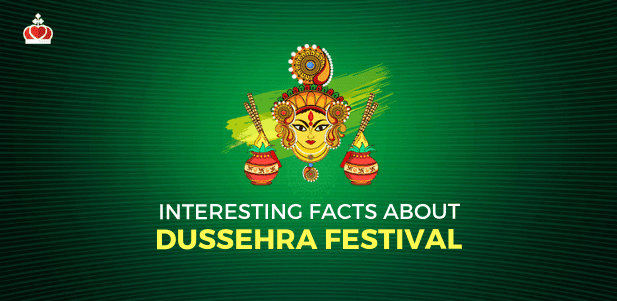Interesting Facts About Dussehra Festival
Dussehra is one of the prime Hindu festivals celebrated across India.

Interesting Facts About Dussehra Festival
Also known as Vijayadashami, it occurs on the tenth day of the Hindu calendar month called Ashwin (falls during September-October Gregorian calendar months). Dussehra festival reminds us that, in the end, good always triumphs the evil.
The festival is celebrated differently in various regions of India. For instance, in most of the north, west, and southern regions, devotees burn effigies of Ravana while in the east and north-eastern states, they immerse Durga idols as a send-off to her.
Whatever the system, this festival is a welcome to good times in everyone’s life!
Here are some facts and stories related to the Dussehra festival that might interest you:
- Meaning and Origin of ‘Dussehra’ and Vijaya Dashami
- Dussehra was derived from the Sanskrit term ‘Dasha’ +’Hara’ the literal meaning of which is the defeat of the Sun. According to a story, it is said that the Sun wouldn’t have risen if Ravana was not defeated by Rama. A.k.a Vijaya Dashami, literally means the victorious 10th day which signifies the victory of Durga over Mahishasura, on the tenth day.
- Who killed Mahishasura?
- Mahishasura was an extremely powerful demon god who tormented innocent people. The three chief Hindu gods Brahma, Vishnu, and Mahesh merged their powers to create Shakti who fought the demon for 9 whole days and finally banished him on the tenth which came to be known as Vijaya Dashami.
Also Read: Online Games You Can Play To Jazz Up Your Diwali Party
- Non-vegetarian food during Navratri? -Truth revealed.
- The eastern part of India has a very interesting story not many are aware of. They consider goddess Durga or Uma as their daughter who visits them during Durga Puja and returns to her husband’s home on the 10th day. So, if you’ve ever wondered why some people eat nonvegetarian during the festival, well now you know. It’s because we ‘feast’ and not ‘fast’ when our daughter comes home.
- Marks climate and crop change
- Dussehra also marks the climatic transition from monsoon/fall to winter. It begins to get colder from the day on. It also marks the change in agricultural crops – the Kharif crops are harvested now, making way for the rabi crops to be harvested after Diwali.
- Not restricted to India
- Dussehra is not just an Indian festival. It is celebrated in a grand manner in the countries Nepal, Bhutan, and Malaysia.
- Burning 10-headed Ravana
- It is believed that the ten heads of Ravana symbolize the ten bad qualities of a soul – Lust (Kama), Anger, (Krodh), Attraction (Moh), Greed (Lobh), Pride (Mada), Jealousy (Matsarya), Selfishness (Swaarth), Injustice (Anyaay), Cruelty (Amaanavta) and Ego (Ahankaar).
- So, the effigies of Ravana are burnt symbolizing the destruction of all these 10 bad qualities in us.
Apparently, the smoke emitted from burning the effigies got rid of germs that spread infections as the winter commences.
- Ashoka and Dr. Ambedkar’s conversion to Buddhism
- As per legend, Dussehra was the day when the great emperor Ashoka converted to Buddhism. Likewise, Dr. Ambedkar too had chosen the path of Buddhism starting this day.
While these interesting pieces expand your understanding of this great festival, the takeaway remains the same – The good wins over the evil!
So, go ahead and immerse yourself in great festivities. Enjoy the grand Dussehra Offers running at Classic Rummy and also experience great gaming with our all-new Classic Rummy Android Mobile App! Have a great Dussehra!








